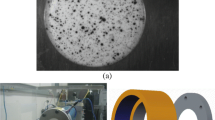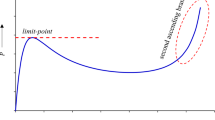Abstract
A physically-based model is presented for the simulation of a new type of deformable objects—inflatable objects, such as shaped balloons, which consist of pressurized air enclosed by an elastic surface. These objects have properties inherent in both 3D and 2D elastic bodies, as they demonstrate the behaviour of 3D shapes using 2D formulations. As there is no internal structure in them, their behaviour is substantially different from the behaviour of deformable solid objects. We use one of the few available models for deformable surfaces, and enhance it to include the forces of internal and external pressure. These pressure forces may also incorporate buoyancy forces, to allow objects filled with a low density gas to float in denser media. The obtained models demonstrate rich dynamic behaviour, such as bouncing, floating, deflation and inflation.
Similar content being viewed by others
References
Baraff D, Witkin A. Large steps in cloth simulation. In Proc. SIGGRAPH 98, Orlando, USA, pp.43–54.
Debunne G, Desbrun M, Cani M P, Barr A H. Dynamic real-time deformations using space & time adaptive sampling. In Proc. SIGGRAPH 2001, Los Angeles, USA, pp.31–36.
Ďurikovič R. Animation of soap bubble dynamics, cluster formation and collision. Computer Graphics Forum, 2001, 20(3): 67–76.
Kück H, Vogelgsang C, Greiner G. Simulation and rendering of liquid foams. In Proc. Graphics Interface 2002, Calgary, Alberta, Canada, pp.81–88.
Hong J M, Kim C H. Animation of bubbles in liquid. Computer Graphics Forum, 2003, 22(3): 253–262.
Grinspun E, Krysl P, Schröder P. CHARMS: A simple framework for adaptive simulation. In Proc. SIGGRAPH 2002, San Antonio, Texas, USA, ACM Trans. Graphics, 21(3): 281–290.
Li L, Murali D, Gay R K L. Aerodynamic force model for animating cloth motion in air flow. The Visual Computer, 1996, 12(2): 84–104.
Cohen L D, Cohen I. Finite-element methods for active contour models and balloons for 2-D and 3-D images. IEEE Trans. Pattern Analysis and Machine Intelligence, 1993, 15(11): 1131–1147.
Chen Y, Medioni G. Description of complex objects from multiple range images using an inflating balloon model. Computer Vision and Image Understanding, 1995, 61(3): 325–334.
McDonnell K T, Qin H, Wlodarczyk R A. Virtual clay: A real-time sculpting system with haptic toolkits. In Proc. the 2001 Symposium on Interactive 3D Graphics, Research Triangle Park, North Carolina, USA, pp.179–190.
Rappoport A, Sheffer A, Bercovier M. Volume-preserving free-form solids. IEEE Trans. Visualization and Computer Graphics, March 1996, 2(1): 19–27.
Promayon E, Baconnier P, Puech C. Physically-based deformations constrained in displacements and volume. Computer Graphics Forum, 1996, 15(3): 155—164.
Bridson R, Marino S, Fedkiw R. Simulation of clothing with folds and wrinkles. In Proc. the ACM SIGGRAPH/Eurographics Symposium on Computer Animation, San Diego, California, USA, 2003, pp.28–36.
Grinspun E, Hirani A, Desbrun M, Schröder P. Discrete Shells. In Proc. the ACM SIGGRAPH/Eurographics Symp. Computer Animation, San Diego, California, USA, 2003, pp.62–67.
O’Brien J F, Hodgins J K. Graphical Modeling and Animation of Brittle Fracture. In Proc. ACM SIGGRAPH 99, Los Angeles, USA, pp.137–146.
Landau L D, Lifshitz E M. Theory of Elasticity. Pergamon Press, 1986.
Desbrun M, Meyer M, Schröder P, Barr A H. Discrete differential-geometry operators for triangulated 2-manifolds. In VisMath′02, Berlin-Dahlem, Germany, 2002, pp.237–242.
Author information
Authors and Affiliations
Corresponding author
Additional information
A preliminary version of this paper appeared in Proc. Pacific Graphics 2005, Macau.
Ling Li received her B.Sc., M.Eng. and Ph.D. degrees in computer science and engineering from Sichuan University, China Academy of Post and Telecommunication, and Nanyang Technological University (Singapore) respectively. She worked as an assistant professor and associate professor in Nanyang Technological University from 1994 to 2002. She has been a senior lecturer in the Department of Computing, Curtin University of Technology, Australia since June 2002. Her main research interests include physically-based and video-based computer graphics and animation.
Vasily Volkov received his B.Sc. and M.Sc. degrees in applied mathematics and physics from Moscow Institute of Physics and Technology, Russia, and his M.Eng. degree in computer engineering from Nanyang Technological University, Singapore. He was an academic visitor in the Department of Computing of Curtin University of Technology from May 2004 to April 2005. Currently, he is enrolled in the Ph.D. program in computer science at the University of California at Berkeley. His main research interests are in physically-based and mathematical methods in computer graphics.
Rights and permissions
About this article
Cite this article
Li, L., Volkov, V. Inflatable Models. J Comput Sci Technol 21, 154–158 (2006). https://doi.org/10.1007/s11390-006-0154-1
Revised:
Issue Date:
DOI: https://doi.org/10.1007/s11390-006-0154-1




